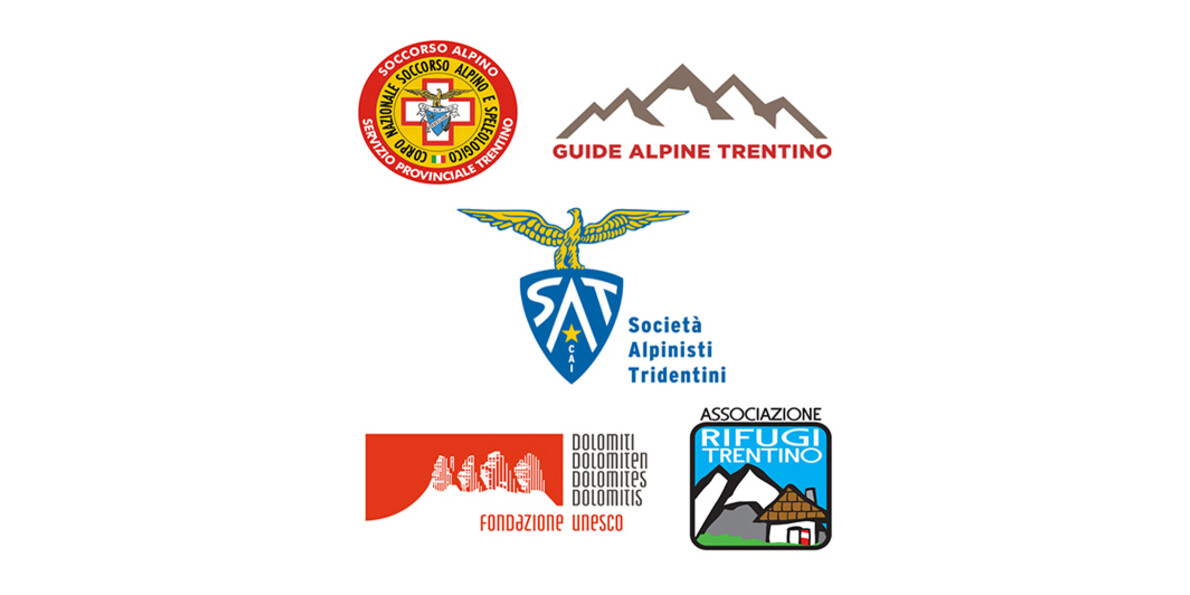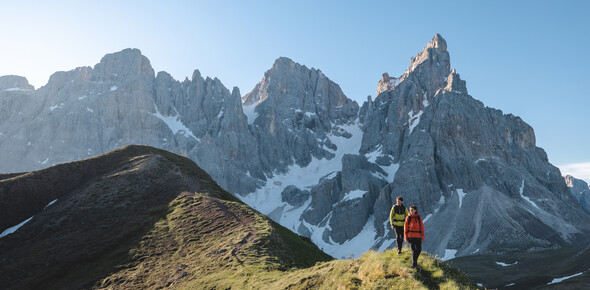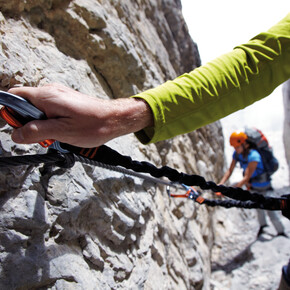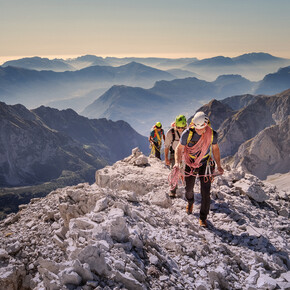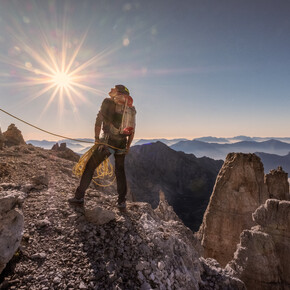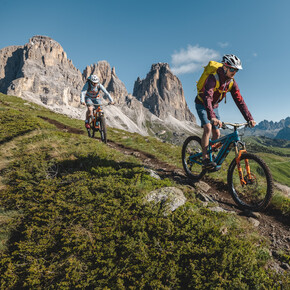Caution in the mountains
How to enjoy the mountains with tips from those who know and love this environment
If you are a mountain lover, you already know the excitement of hiking at altitude, following a via ferrata or testing your climbing skills: the important thing is to be prudent, approaching these activities in an informed and careful manner.
To help you remember how to stay safe, we have created a handbook and five guides, in collaboration with the UNESCO Dolomites Foundation, the Trentino Alpine-Hut Association, the S.A.T. Trentino Alpine Society, and the Trentino Alpine Rescue and Alpine Guide organisations.
We have also compiled the most frequently asked questions from visitors, like you, who love to explore the mountains and asked various experts for their answers.
Read the FAQs and follow their advice!
Clothing and equipment in the mountains
Always adopt a layered approach to clothing, with layers ranging from light to more heavyweight. Take a change of clothes in your rucksack, as well as waterproof and windproof clothing, gloves and a hat, even if the sun is shining. Do not forget sunglasses and high-protection suncream, footwear suitable for the activity in question, a first-aid kit, a power bank to recharge your phone in the event of an emergency and sufficient food and water for the activity.
If you are sleeping in an alpine lodge, take a sleeping-bag liner or lightweight sleeping bag, a flask and a pair of light slippers (if they are not provided by the hut), along with a head torch.
In the mountains, it is essential that you always know exactly where you are. It is important to always take a digital and/or paper topographic map in addition to a wrist altimeter and a compass (a digital compass on a smartphone is sufficient). These tools are useful to find your way, but you must know how to use them correctly, and you should therefore practice before you set off! Walking poles are also very handy.
If there is a section with cables, in addition to standard hiking equipment, you need a helmet, harness, and certified via ferrata kit with shock-absorber lanyard, in addition to a rope and carabiner to position yourself if you cannot continue. It is very important to have a pair of gloves.
To hike on a glacier, it is necessary to be experienced both in techniques to make progress over different gradients and in the use of mountaineering equipment. Equipment you should remember to take: rope, ice axe, crampons, harness, helmet, at least two ice screws, two or three ropes, four or five locking carabiners and technical equipment suitable for emergency manoeuvres for climbing and recovery from a crevasse.
Organising the hike
For up-to-date information you can also follow the portal for all trails on the website SAT Trail Commission.
Always follow the red and white markers and carefully read signs to understand the right direction, altitude and estimated times. Never leave the trail and if you are unsure, return to a recognised point and consult a paper or digital map, which you should always have with you if you are not completely familiar with the route.
Generally, tourist trails do not present particular difficulties as they are below 2,000 m altitude. Hiking trails, on the other hand, can have more challenging features given that they often lead to alpine lodges and huts and require good orienteering skills, suitable footwear and proper equipment. Finally, trails for expert hikers cross demanding and steep terrain and require confident footing, experience and knowledge of the mountain environment.
In the mountains, times often depend not only on your level of fitness but also on weather conditions. As a general rule, in one hour at average walking speed you can cover 300–350 m change in altitude and up to 3–4 km on level ground. The distances that can be covered decrease after 2–3 hours walking and if the altitude is over 2,000 m. Be prudent: if you are just starting out, do not take on a very long route, start gradually.
Avoid going alone unless you have no other choice. You will have more fun together and it is safer! If you are a beginner, do not hesitate to ask for advice or consult a mountain professional: an Alpine Guide or Mid-Mountain Guide.
When walking on a glacier it is essential to know how to identify all of the possible hazards (natural or related to the route or group) in order to adopt all possible safety measures and minimise risk to an acceptable level.
If you are a beginner, get a guide who lives and works in the mountains: an Alpine Guide.
Weather
Generally, the websites of regional weather centres, available at the following links: http://www.meteoregioni.it/ - For Trentino meteotrentino.it. Or the weather website of the Italian Airforce http://www.meteoam.it/
To check the weather conditions in real time, it is very useful to consult satellite images, radar, data from weather stations on the ground and mapping of lightning strikes.
During the summer, downpours and storms are frequent, particularly in the mountains and narrower valleys. In the mountains, storms normally occur in the afternoon or evening but sometimes they can develop in the morning or during the night. For this reason, you are advised to hike in the morning unless a weather front is forecast to pass through. It is also useful to monitor gathering cumuliform clouds. If you see clouds that stretch very high upwards in the morning, this means that the atmosphere is unstable and it is therefore prudent to plan the hike to ensure you reach a safe place (building or car) in a short time in case conditions worsen.
Are written forecasts preferable to those that use icons? In a text, the forecaster can describe the forecast indicating the different levels of uncertainty. Forecasts using icons alone are approximate and cannot communicate the level of uncertainty and/or variability of the forecast. While the icons for full sun or a cloud with two rain drops indicate good and bad weather, respectively, the icon with a sun, cloud and raindrop together may indicate an uncertain forecast or good weather in the morning and bad weather in the afternoon or vice versa.
Alpine lodges
The website of the Trentino alpine-hut association indicates general opening for all alpine lodges. To be sure, it is always best to contact the lodge directly (particularly at the beginning and end of the season).
A hut is a structure that is unstaffed, without a meal service and generally without toilet facilities. It is a very simple structure, without heating and is primarily only used in emergencies.
An alpine lodge is accommodation that is managed or supervised and open to the public, designed to meet the needs of mountaineers and hikers and conveniently set-up and run to offer hospitality and the option to rest, eat and sleep, along with associated services, and is always prepared to offer first-aid assistance. There are alpine lodges at different altitudes, some historic and some newer, and they are all equipped with beds, generally divided into dormitories and private rooms. Bathroom facilities are usually shared.
It is always necessary to book to sleep in an alpine lodge. In the majority of alpine lodges, it is mandatory to use a sleeping-bag liner and it is necessary to take your own towels, slippers and toiletry kit. Always ask the alpine lodge for confirmation.
Recommendations from the SAT Medical Commission
- What should I do if a tick bites me?
Ticks are arachnids, the same class as spiders, mites and scorpions. They have eight legs and are only a few millimetres in size, although once they’ve had a blood meal, they become much larger. The head is indistinguishable from the body and is equipped with mouthparts, called the rostrum, which is capable of penetrating skin and sucking the blood of its hosts. So we can say that when a tick bites, it tends to bury itself under the skin more and more deeply as time passes. It’s important to remove ticks as soon as possible, also to prevent it from injecting potentially infected saliva into the bloodstream. After removing the tick it’s important to keep the site of the bite under observation for 3 to 30 days, checking for the possible appearance of a pale-pink circular halo, or one that tends to radiate outwards. If you see this, you should contact your doctor, who will determine whether or not to prescribe a course of antibiotics to combat bacterial Lyme disease.
- How do I recognize a tick bite?
If the tick has detached itself, its bite is indistinguishable from other insect bites. It’s important to keep the site of the bite under observation for 3 to 30 days, to check for the possible appearance of a pale-pink circular spot or one that tends to radiate outwards. If you see this, you should contact your doctor, who will determine whether or not to prescribe a course of antibiotics to combat bacterial Lyme disease.
- How should I remove a tick?
It’s important to remove ticks as soon as possible, also to prevent it from injecting potentially infected saliva into the bloodstream. No special substances are needed to remove a tick. Take a pair of disinfected tweezers, and place them as close as possible to your skin, which should also first be disinfected. Firmly grasp the tick and pull upwards, wiggling gently, delicately and repeatedly but without crushing it. After removing the tick it’s important to keep the site of the bite under observation for 3 to 30 days, checking for the possible appearance of a pale-pink circular halo, or one that tends to radiate outwards. If you see this, you should contact your doctor, who will determine whether or not to prescribe a course of antibiotics to combat bacterial Lyme disease.
- How can I prevent tick bites? Should I get vaccinated?
Sprays and lotions used to reduce the risk of tick bites are available, but don’t guarantee total prevention. You can use suitable clothes: the advice is to wear light-coloured clothes, which makes it easier to spot ticks. Also, it’s better to wear long-sleeved tops and long trousers, socks, and boots or closed shoes. Getting vaccinated is advisable as there is an ever-increasing risk of contracting TBE, a serious viral encephalitis that’s difficult to diagnose but preventable with a complete course of vaccination. For further information
For further information, download the PDF file ‘Conoscere le zecche' (be tick aware) published by the SAT
To learn more about this topic, visit the SAT Medical Commission’s page: https://www.sat.tn.it/spazio-commissioni/medica/
CONTENT TAKEN FROM THE SAT MEDICAL COMMISSION
The caterpillars of the pine processionary moth are hairy and march nose to tail between the trees they rely on for food. They can damage plants and cause injuries to people and animals, and for this reason they need to be eradicated. Around January, the caterpillars build white cocoon-like silken nests in the tops of pine trees, which can sometimes be as big as a soccer ball. Pine processionaries are easy to recognize as they typically march along the ground in nose-to-tail ‘processions’, releasing their poisonous hairs into the air as they go. Among the various problems the pine processionary can cause in animals, it’s worth highlighting those caused when its hairs come into contact with the mucous membranes of the eyes and mouth. Depending on the part of the body that touches the pine processionary, in humans they can cause painful skin rashes may develop that can be extremely itchy. If they come into contact with the eyes there is a risk they can cause conjunctivitis, while if they touch the mouth or nose they can cause inflammation of the respiratory tract. To reduce the risk of injury resulting from contact with the pine processionary it’s essential to wash affected parts thoroughly with plenty of fresh water. If you spot a pine processionary, simply avoid touching it and keep your distance.
To learn more about this topic, visit the SAT Medical Commission’s page: https://www.sat.tn.it/spazio-commissioni/medica/
CONTENT TAKEN FROM THE SAT MEDICAL COMMISSION
- Should I always carry a first aid kit in the mountains?
It’s strongly recommended. To better prepare it, it’s advisable to consider the type of outing you plan to undertake, and whether this presents a high or low risk of accidents. For example, dangers can be connected to environmental factors such as rain, lightning, extreme cold, or the nature of the terrain. In the latter case you need to consider the various ascents and descents, the height gain involved, whether there are exposed paths and so on. We recommend you consider these aspects when preparing your first aid kit to ensure you always have exactly what you need, without adding excessive weight to your backpack. Regardless of its size, your kit will need a soft, waterproof case, which can be stowed in an external pocket of your backpack so it’s easily accessible.
- What should I include in my mountain first aid kit?
There are many first aid kits commercially available and these provide a great starting point. You must build your own kit bearing in mind that everyone has their own needs – especially when it comes to personal health and safety. So we recommend you always add items you deem necessary even when buying a ready-made kit. To give you some guidance about what may be useful to you, here is a checklist of items to include in your kit. Of course, these are only suggestions.
- Sterile pads and medicated gauze dressings;
- Plasters of various sizes for cuts and blisters;
- Scissors and tweezers;
- A dry ice pack for bruises, insect bites, and burns;
- A thermal blanket.
To learn more about this topic, visit the SAT Medical Commission’s page: https://www.sat.tn.it/spazio-commissioni/medica/
CONTENT TAKEN FROM THE SAT MEDICAL COMMISSION
When planning your mountain hikes, make sure you choose routes that match your physical and technical abilities, read up on the area you intend to visit and equip yourself with the appropriate maps. Carry everything you need for any emergency in your backpack, including a minimum amount of first aid items. Preferably never head into the mountains alone and in any case let someone know the your planned route, and let them know when you get back. Get an up-to-date weather forecast and keep a close watch on any changes to the weather. When in doubt, turn back. In case of emergency, call 112 (App Where ARE U) and explain your situation. To do this, make sure you always have your mobile phone charged and a portable battery charger. If your phone doesn't have a signal, try to get to an area where there is a signal and call 112.
To learn more about this topic, visit the SAT Medical Commission’s page: https://www.sat.tn.it/spazio-commissioni/medica/
CONTENT TAKEN FROM THE SAT MEDICAL COMMISSION
Staying well hydrated in the mountains is essential. In addition to adequate nutrition, all sports, and that includes hiking, require adequate hydration, especially during the summer months. It’s vitally important to drink regularly including in the days before your hike. It’s essential to carry at least one bottle of water when walking at high altitude. It's important to drink before you feel thirsty, so drink regularly in a manner adequate for the atmospheric temperature and the intensity of the activity you’re doing. In the mountains, in addition to water, you can drink tea with or without sugar, regular isotonic drinks or diluted fruit juice.
To learn more about this topic, visit the SAT Medical Commission’s page: https://www.sat.tn.it/spazio-commissioni/medica/
CONTENT TAKEN FROM THE SAT MEDICAL COMMISSION
Altitude sickness occurs when a person is at high altitudes, usually this means above 2,000 metres. This happens because, as you ascend, the atmospheric pressure drops and less oxygen reaches your lungs.
Symptoms of altitude sickness may include:
- a headache,
- excessive tiredness,
- lack of appetite
To alleviate the symptoms of altitude sickness, the general advice is to descend to a lower altitude. However, the main treatment is based on prevention, meaning ensuring adequate acclimatization and heeding a number of precautions which considerably reduce the risk of suffering from altitude sickness.
To learn more about this topic, visit the SAT Medical Commission’s page: https://www.sat.tn.it/spazio-commissioni/medica/
CONTENT TAKEN FROM THE SAT MEDICAL COMMISSION
Ascents using lifts must be carefully evaluated considering the height gain and maximum altitude reached. Children and the elderly can be more prone to dehydration and heatstroke.
To learn more about this topic, visit the SAT Medical Commission’s page: https://www.sat.tn.it/spazio-commissioni/medica/
CONTENT TAKEN FROM THE SAT MEDICAL COMMISSION
When you head out to the mountains, adequate nutrition is by no means secondary. Indeed, it’s vitally important. Both mountaineering and hiking require a high supply of energy. Nutrition and physical performance are closely connected and linked to accident prevention in the mountains. The greatest danger is when you get hungry and thirsty and don’t have any food or water, or worse still, when your sugar levels drop. This situation heightens stress and increases fatigue and in some cases can cause weakness and dizziness, making it increasingly difficult to think clearly. Breakfast is one of the three main meals of the day and should be more substantial than a simple cup of coffee. During your trip, the general rule is to eat little and often. The best way to achieve this is by eating cereal-based energy bars, some dried fruit and nuts, dark chocolate or some fruit. At lunchtime the recommendation is to eat, but don’t overdo it because you also need to consider the descent. And after your trip? Just eat whatever you want!
To learn more about this topic, visit the SAT Medical Commission’s page: https://www.sat.tn.it/spazio-commissioni/medica/
CONTENT TAKEN FROM THE SAT MEDICAL COMMISSION
Useful information
The local tourist boards and the Trentino Board of Alpine Guides can provide information and contact details for mountain professionals that can take you on hikes.
In the mountains, you cannot always count on your mobile phone and internet connection. This is why you should plan and research the route you intend to take before departure, as well as paying the utmost attention to signs along the way that provide the necessary information on the destinations of trails. Despite the presence of these signs, do not forget to always take a topographic map, which may be needed if you get lost and cannot use your mobile phone. Try to remember points along the way when your mobile phone did have signal in case you need to return to one to make a call.
In an emergency, call one one two - 1 1 2, the universal number for all emergencies. Even if you do not have network coverage from your operator, the emergency number may still work if another operator has signal in the location where you are (generally indicated by “emergency calls only”). If there is no coverage from any operator you can always return to the last place you remember having signal.
When making the call, it is important to remain calm and answer the operator’s questions in detail. The main information you must provide is:
- the exact site of the accident (e.g. place name, GPS coordinates, trail number, altitude, orientation of face [e.g. north face, south face, etc.], name of via ferrata or face you are climbing, etc.)
- activity engaged in
- number of people involved
- number of people injured, their state of health and the details of the accident
- weather conditions at the site of the accident
- telephone number to call you back on.
Remember to keep the line free so that emergency personnel can call you back if necessary.
Not all species found in the mountains are edible. Only species of mushrooms, herbs, berries and forest fruits that can be identified with 100% certainty should be collected and eaten, and only if permitted in the location where they are found (in parks or nature reserves this is usually prohibited).
You can take dogs on the trails, but it is recommended to keep them on a lead (in certain areas this is mandatory) to avoid them bothering wild animals that live in the mountains or getting in the way of other hikers. If they get loose, you should not follow them into particularly challenging terrain, as this could put you in serious danger.
Contact cable-car operators and alpine lodges to find out if dogs are welcome where you are hoping to visit and follow the rules they provide you with. Owners are responsible for the behaviour of their dogs in the mountains too!
Muzzles are not always mandatory, but it is best to bring one to be prepared for all circumstances.
